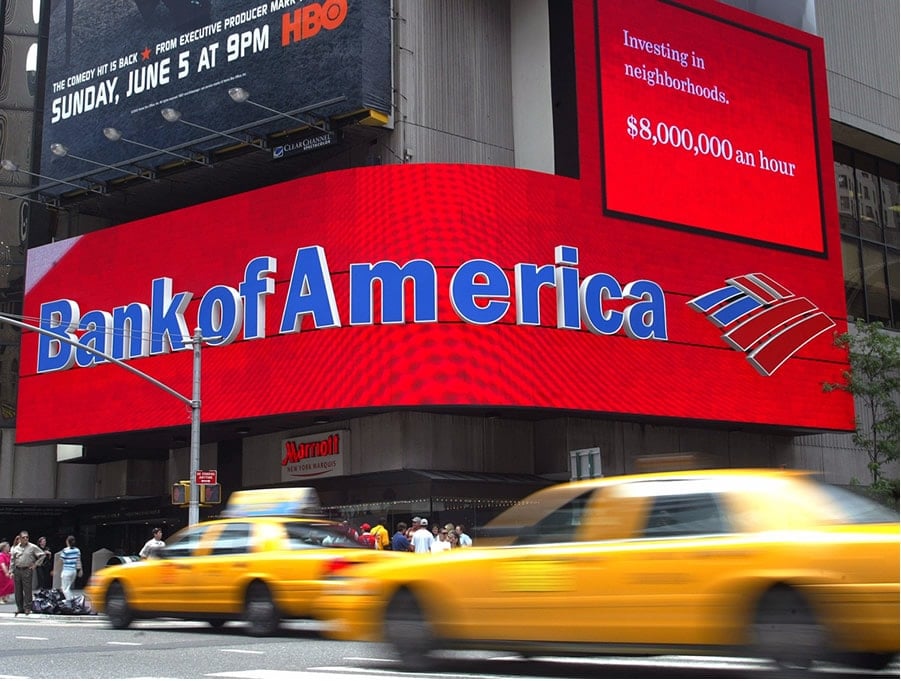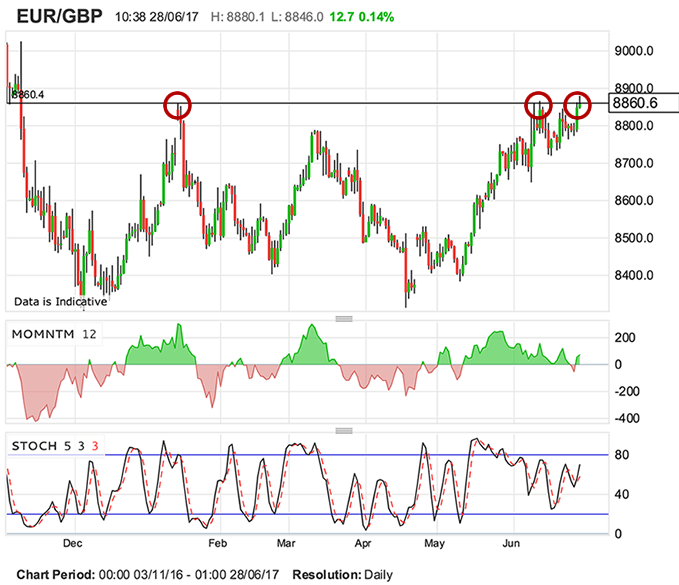Pound Sterling Weakness Against Euro Done for Now say BofAML, Close EUR/GBP Trade

The Euro's mid-2017 rally against the British Pound might have finally run its course say strategists at Bank of America Merrill Lynch Global Research (BofAML).
As such, BoFAML have announced they are exiting a profitable trade recommendation that sought to profit on the recent bout of Euro strength against the Pound.
With the Euro having risen to the top of a well-established range, expectations for a fall have been growing and the recommendation to exit the trade was made just before the current bout of strength we are seeing across the Sterling complex.
The impressive forecasting saw strategists believe the Euro would struggle to find buying interest above EUR/GBP 0.8860 as has been the case on three occassions in the recent past.
This technical observation was gifted an intervention by Bank of England Governor Mark Carney who boosted the Pound after he hinted to an audience in Portugal mid-week that the UK might raise interest rates at some point in coming months.
A Bet Against the Pound that has Run its Course
The Eurozone economic recovery and expectations for the European Central Bank’s exit from its quantitative easing programme have ensured the Euro is one of the best-performing global currencies of 2017.
Bank of America Merrill Lynch opened a bet in favour of a rise in EUR/GBP back in May expecting the Euro to outperform.
This view on the Euro paid off handsomely after Mario Draghi finally let the cat out the bag and hinted that tighter monetary conditions were coming in a speech to delegates at the ECB's Forum on Central Banking in Sintra, Portugal on June 28.
BofAML's bet has “performed strongly in the aftermath of comments from ECB President Draghi and is approaching its recent highs,” notes Kamal Sharma, FX Strategist with BofAML.
Highs are seen at 0.8860 where EUR/GBP has failed on three occasions to break.
This equates to a floor at 1.1286 in the Pound to Euro exchange rate.
But with the Euro reaching traditional highs Sharma and his team believe it might now start to struggle.
Analyst Robin Wilkin at Lloyds Bank tells commercial banking clients a deeper sell-off in the Euro is possible.
Wilkin is watching for a potential rise to resistance in the 1.1416/1.1474 region noting that the range lows, highlighted in the above graph, have held.
His studies suggest the potential for levels in the 1.1628-1.1765 region to be tested.
We would however point to the lower panels that show momentum does remain in the Euro’s favour while Stochastics argue the move can extend. This is something to keep in mind as it could spoil the party for Sterling-bulls.
But BofAML's Sharma warns that with the Bank of England having recently adopted a more hawkish stance, "we think the risks to EUR/GBP are symmetric."
Mark Carney's comments about a possible increase in interest rates mark a shift in emphasis https://t.co/kUJCaLileJ pic.twitter.com/1lMhhf11ws
— Bloomberg TV (@BloombergTV) June 28, 2017
Furthermore, Bank of America’s European economic team believes that despite the market excitement around some of ECB President Draghi’s recent comments, the focus should be on the cautious tone which was a common strand through his speech at Sintra.
This may disappoint investors who are expecting further strength in the Euro going forward, as we note here.
In all, these are interesting times for the Euro v Pound from a technical perspective as we are clearly at an inflection point.
Concerning the all-important influence of Brexit on the Pound, Sharma says we will need to see a notable deterioration in sentiment to prompt a more sustained drop.
“The ongoing Brexit negotiations continue to pose downside risks to GBP particularly with the divisions not only between the EU and UK on EU Citizens rights but within the UK government itself. However, we are likely to need to see an escalation in tensions for GBP to come under further weakness versus EUR,” says the analyst.
Beware More Euro Strength on Liberated ECB
As expected, unity with regards to the outlook facing the Euro in the wake of recent events is in short supply.
President Draghi’s speech on Wednesday was digested by markets as a signpost to a future of higher interest rates and the end of quantitative easing.
But there is more, from a pro-Euro perspective.
The speech “was important not because he marked a hawkish shift to policy but because he implicitly signalled that the ECB is not as concerned about low inflation any more: it is now considered temporary,” says foreign exchange strategist George Saravelos at Deutsche Bank.
According to Saravelos, “the language shift is critical because it “liberates” the euro, disinflationary strength in the currency may now matter less for the ECB.”
The analyst notes the shift in language actually coincides with another regime change that has been evolving in recent months and is even more important: “the complete breakdown of EUR/USD with rate differentials suggesting the ECB was losing control of FX anyway.”
For Saravelos, both these observations are critical “because they suggest that the Euro can strengthen despite, not because of higher bund yields”.
In fact, the more the Euro appreciates the more ECB tightening will be slowed.
“The key driver of euro strength is not ECB hawkishness but medium-term rebalancing of structural postcrisis underweights in European assets,” says Sarvelos. “The ECB may not able to do much about it.”
This should serve as a reminder to those watching the Pound to Euro exchange rate that a strong recovery is still out of reach.






